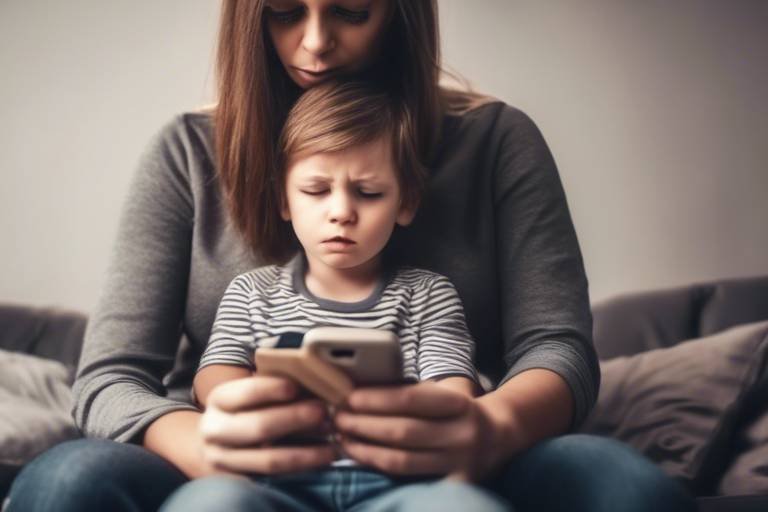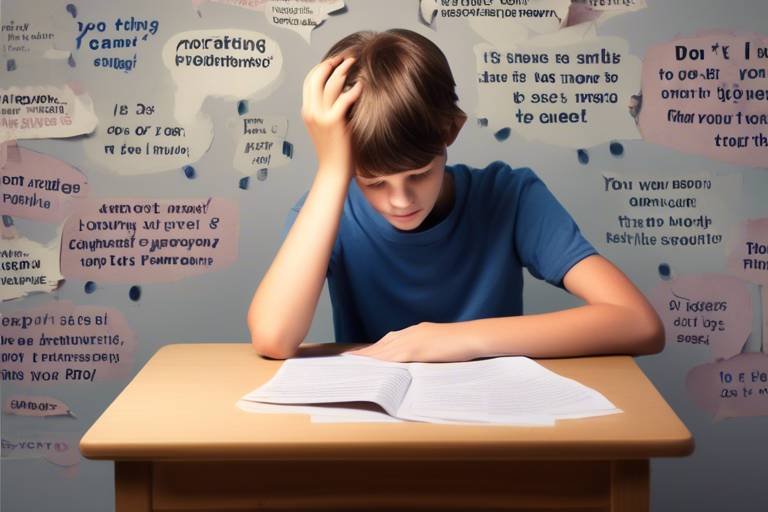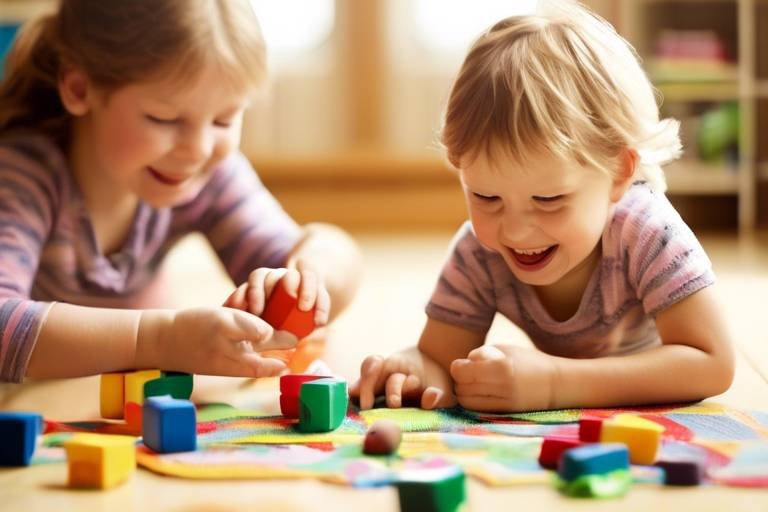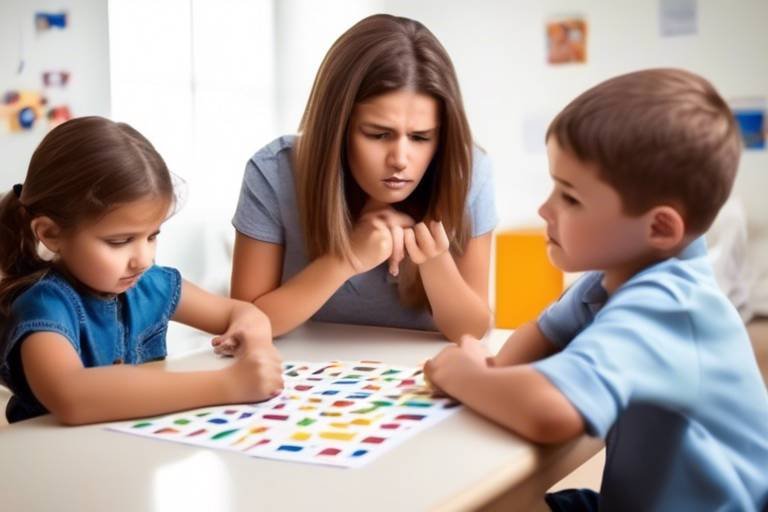Encouraging Generosity In Children: Tips And Ideas
This article explores various strategies and creative ideas to foster a spirit of generosity in children, helping them develop empathy, kindness, and a sense of community from a young age.
To encourage generosity, it's essential to understand what it means. Generosity is more than just giving; it's about creating a mindset that values kindness and compassion. When children learn to be generous, they not only help others but also cultivate their own emotional intelligence and social skills. Think of it as planting seeds in a garden: the more you nurture those seeds, the more they grow into beautiful flowers. Studies have shown that children who practice generosity are often happier and more fulfilled, making it a vital part of their development.
Children learn by example, and one of the best ways to instill a sense of generosity is for parents and caregivers to model generous behavior themselves. This means demonstrating acts of kindness and sharing in everyday situations. For instance, when you help a neighbor or donate to a local charity, narrate your actions to your child. Ask them how they would feel if they were in the other person's shoes. This not only teaches them about generosity but also encourages them to empathize with others. Remember, children are like sponges; they absorb everything they see and hear.
Simple acts of kindness can have a profound impact on a child's understanding of generosity. Here are a few everyday actions that can teach children the value of compassion:
- Helping someone carry groceries
- Writing thank-you notes
- Complimenting a classmate
These small gestures not only make the world a better place but also show children that generosity can be a part of their daily lives.
Engaging in volunteer activities as a family provides children with firsthand experience in giving back. Volunteering can take many forms, from helping at a local soup kitchen to participating in community clean-up days. The benefits are immense: not only does it foster a sense of community and responsibility, but it also strengthens family bonds. When children see their parents actively contributing to the community, they are more likely to adopt similar values. It’s like a team sport; when everyone plays their part, the entire team benefits.
Encouraging children to share their toys, books, or other resources can be a practical way to teach generosity. One effective strategy is to create a sharing box where children can place items they no longer use. This not only teaches them about sharing but also creates a fun and rewarding experience. You might even turn it into a game: who can fill the box the fastest? The excitement of sharing can become a cherished memory rather than a chore.
Empathy is a key component of generosity. To help children develop empathy, engage them in activities and discussions that allow them to understand and care for the feelings of others. For instance, reading stories that highlight different perspectives can open their eyes to others' experiences. Ask questions like, "How do you think that character felt?" This kind of dialogue not only fosters empathy but also helps children articulate their feelings, making them more emotionally intelligent.
Creating opportunities for children to practice generosity can be both fun and educational. Think about organizing a family charity drive or participating in community events. These activities provide a platform for children to learn about the importance of giving back while also engaging with their peers. It’s a win-win situation!
Thoughtful gift-giving can teach children the joy of giving. Encourage them to think about the needs and preferences of others when selecting gifts. For example, they could create personalized gifts, such as handmade cards or baked goods, for friends or family members. This not only shows that they care but also allows them to express their creativity.
Getting involved in community initiatives can deepen children's understanding of generosity. Participating in local events, such as food drives or charity runs, helps them see the impact of their actions. They can also learn about different cultures and communities, fostering a sense of belonging and commitment to helping others. It’s like building a bridge between themselves and the world around them.
Q: How can I encourage my child to be more generous?
A: Start by modeling generous behavior yourself. Engage in acts of kindness and share your experiences with your child. Create opportunities for them to practice generosity through volunteering, sharing, and thoughtful gift-giving.
Q: What age is appropriate to start teaching generosity?
A: You can start teaching generosity as early as preschool age. Simple concepts like sharing toys or helping others can be introduced at this stage.
Q: How can I make sharing fun for my child?
A: Turn sharing into a game! Create a sharing box where they can place items they no longer use, or organize playdates where sharing is encouraged. Celebrate their efforts to share with praise.
Q: Why is empathy important for generosity?
A: Empathy allows children to understand and relate to the feelings of others. When they can put themselves in someone else's shoes, they are more likely to act generously.

Understanding Generosity
To encourage generosity, it's essential to understand what it truly means. Generosity is not just about giving away material possessions; it's a mindset that encompasses kindness, empathy, and a genuine desire to help others. When we talk about fostering generosity in children, we are essentially nurturing their ability to connect with others and recognize the value of community. This vital trait can shape their social skills and enhance their emotional intelligence, which are crucial for building meaningful relationships throughout their lives.
Generosity plays a significant role in child development. Research shows that children who engage in generous acts tend to have better social interactions and are more likely to develop strong friendships. They learn to appreciate the feelings of others, which fosters a sense of belonging and community. This understanding can be broken down into several key components:
- Empathy: The ability to understand and share the feelings of others.
- Kindness: Acts of goodwill that promote a positive environment.
- Community Awareness: Recognizing the needs of the community and taking action to address them.
By instilling these values early on, parents and caregivers can help children develop a strong foundation for a generous spirit. This foundation not only benefits the children themselves but also creates a ripple effect that can positively impact their peers and the wider community. Imagine a world where every child grows up understanding the importance of giving and sharing; it would be a place filled with compassion and support.
Furthermore, teaching children about generosity can also lead to personal growth. When children participate in acts of kindness, they often experience a sense of fulfillment and happiness. This positive reinforcement encourages them to continue being generous, creating a cycle of giving that benefits both the giver and the receiver. It's like planting a seed; with the right nurturing, that seed can grow into a beautiful tree that provides shade and fruit for many.
In conclusion, understanding generosity is the first step in encouraging it among children. It’s not just about giving; it’s about creating a mindset that values empathy, kindness, and community involvement. By modeling these behaviors and providing opportunities for children to practice generosity, we can help them grow into compassionate adults who contribute positively to society.

Modeling Generosity
Children are like little sponges, soaking up everything they see and hear. This means that as parents and caregivers, we have a unique opportunity to shape their understanding of generosity through our own actions. Modeling generosity isn't just about telling children to be kind; it's about showing them what it looks like in real life. When kids witness adults engaging in acts of kindness, sharing, and helping others, they begin to internalize these behaviors and understand their importance.
For instance, think about the last time you held the door open for someone or shared a meal with a friend. These seemingly small acts can leave a lasting impression on a child's mind. They start to see generosity not just as a concept, but as a way of life. It’s essential to make these actions part of your daily routine. Whether it’s donating clothes, helping a neighbor, or simply offering a smile to a stranger, every little bit counts. Remember, your actions speak louder than words!
Here are some practical ways to model generosity in everyday situations:
- Share with Others: Whether it’s your time, resources, or even a favorite toy, sharing shows children that generosity can be fun and rewarding.
- Practice Gratitude: Regularly express gratitude for what you have and encourage your children to do the same. This fosters an appreciation for both giving and receiving.
- Engage in Community Service: Participate in local charity events or volunteer as a family. This not only teaches children the value of giving back but also strengthens family bonds.
Additionally, storytelling can be a powerful tool in modeling generosity. Share stories of people who have made a difference in their communities or who have gone out of their way to help others. Discuss the emotions involved in these acts—how they felt, what motivated them, and the impact it had on others. This not only makes the concept of generosity relatable but also sparks conversations about empathy and kindness.
Incorporating these practices into your daily life can create a nurturing environment where generosity thrives. It's important to remember that children are always watching and learning from us. By embodying the principles of generosity, we can inspire them to develop their own compassionate habits. So, the next time you think about teaching your child to be generous, ask yourself: are you modeling the behavior you want to see? The answer could be the key to raising a kind and empathetic child.

Acts of Kindness
Acts of kindness are like little seeds that, when planted, can grow into something beautiful. They have the power to change someone's day, or even their life. Teaching children the importance of these small gestures can instill a sense of empathy and generosity that lasts a lifetime. But what exactly does it mean to perform an act of kindness? It can be as simple as offering a smile to a stranger or as involved as helping a neighbor with groceries. The beauty of kindness is that it comes in many shapes and sizes!
One of the most effective ways to teach children about kindness is through real-life examples. When they see their parents or caregivers engaging in kind acts, they are more likely to mimic that behavior. For instance, if a child observes their parent holding the door open for someone or offering words of encouragement to a friend, they learn that these actions are valuable and impactful. It's important to remember that children are always watching and learning from the adults around them.
To make this learning process even more engaging, consider incorporating some fun and interactive activities that promote kindness. Here are a few ideas:
- Kindness Jar: Create a jar where family members can drop in notes about kind acts they’ve done or witnessed throughout the week. At the end of the week, read them together as a family to celebrate the positive impact of kindness.
- Kindness Challenges: Set up weekly challenges where each family member has to perform at least one act of kindness. This could be anything from complimenting a friend to helping someone in need.
- Thank You Notes: Encourage children to write thank you notes to people who have made a difference in their lives, whether it's a teacher, a friend, or a family member. This not only shows appreciation but also spreads positivity.
Moreover, it’s essential to discuss the impact of these acts. When children understand how their actions can make others feel, they are more likely to continue being kind. You could ask questions like, “How do you think your friend felt when you shared your toys?” or “What do you think would happen if everyone did one kind thing every day?” Such discussions can help kids connect their actions with emotions, reinforcing the idea that kindness is a powerful tool for building relationships and community.
Additionally, remember that kindness is not just about grand gestures. Often, it’s the small, everyday actions that count the most. Encourage your children to look for opportunities to be kind in their daily lives, whether it’s helping a sibling with homework, sharing a snack, or simply listening to a friend who is feeling down. These small acts can create a ripple effect, inspiring others to act kindly as well.
In conclusion, teaching children about acts of kindness is not just about the actions themselves; it’s about fostering a mindset of empathy and generosity. By modeling kind behavior, creating opportunities for them to practice, and discussing the effects of their actions, we can help children grow into compassionate individuals who understand the importance of giving back to their communities.
Q: How can I encourage my child to be more generous?
A: Start by modeling generous behavior yourself. Engage in small acts of kindness and involve your child in these activities. Discuss the importance of empathy and the positive effects of generosity.
Q: What age should I start teaching my child about kindness?
A: It’s never too early! Even toddlers can understand simple acts of kindness. As they grow, you can introduce more complex concepts of empathy and community service.
Q: How can volunteering benefit my child?
A: Volunteering helps children develop a sense of responsibility, community awareness, and empathy. It also provides them with the opportunity to meet new people and learn valuable life skills.

Volunteering Together
Engaging in volunteer activities as a family is not just a way to give back to the community; it’s an incredible opportunity to bond, learn, and grow together. When children participate in volunteering, they gain firsthand experience of what it means to help others, which is a crucial lesson in generosity. Imagine the joy of working side by side with your child, planting trees in a local park, or serving meals at a shelter. These shared experiences not only create lasting memories but also instill values of kindness and community service.
Volunteering together can take many forms, and the best part is that it can be tailored to fit your family's interests. Here are some ideas to consider:
- Animal Shelters: Spend a day at a local animal shelter, helping to care for animals. This teaches children compassion and responsibility.
- Food Drives: Organize a food drive in your neighborhood and involve your children in collecting and sorting food items.
- Community Clean-Up: Participate in a community clean-up day. Not only does this beautify your surroundings, but it also teaches children the importance of taking care of their environment.
- Senior Centers: Visit a local senior center and engage with the elderly. Children can learn valuable life stories and develop respect for older generations.
When families volunteer together, they not only contribute to a cause but also strengthen their own relationships. Children observe their parents' commitment and enthusiasm, which encourages them to adopt similar attitudes. It’s like planting seeds of generosity that will grow throughout their lives. The conversations you have during these activities can be just as impactful as the work itself. Discussing why you’re volunteering, the people you’re helping, and how it makes you feel can deepen their understanding of empathy and compassion.
Moreover, volunteering can spark a sense of responsibility in children. They begin to understand that their actions can make a difference in someone else's life. This realization is powerful; it transforms the way they view the world and their role in it. As they grow, this sense of responsibility can lead them to seek out more opportunities to give back, creating a lifelong habit of generosity.
In conclusion, volunteering together as a family is a profound way to teach children the values of generosity and community involvement. It opens their eyes to the needs of others and allows them to actively participate in making a difference. So why not look for a local opportunity this weekend? You might just find that the experience enriches your family in ways you never imagined.
Q: What age is appropriate for children to start volunteering?
A: Children can start volunteering as early as preschool age, with age-appropriate activities. As they grow, they can take on more responsibilities in various volunteer roles.
Q: How can I find volunteering opportunities in my area?
A: Websites like VolunteerMatch.org or local community centers often list volunteer opportunities. You can also check with local charities or non-profits directly.
Q: What if my child is shy or reluctant to volunteer?
A: Start with small, low-pressure activities that align with their interests. Gradually introduce them to larger groups or projects as they become more comfortable.

Sharing Resources
Encouraging children to share their resources is a fantastic way to instill the values of generosity and cooperation from an early age. When kids learn to share, they not only contribute to the happiness of others but also experience the joy that comes from giving. Think of sharing as planting seeds of kindness that can grow into a beautiful garden of empathy and community spirit. But how can parents make sharing a fun and rewarding experience?
One effective approach is to create an environment that celebrates sharing. For instance, you could organize a toy swap party where children can bring their toys and exchange them with friends. This not only teaches them about sharing but also about valuing the belongings of others. It’s like a treasure hunt where every child walks away with something new and exciting! Moreover, it encourages them to think critically about what they truly need and what they can pass on to others.
Another great way to promote sharing is by involving children in community projects. For example, you could encourage them to donate clothes or books they no longer use. This can be a powerful lesson in understanding that their unused items can bring joy to others. You might say, “Imagine how happy a child will be to receive your favorite book!” This helps children visualize the impact of their generosity.
Additionally, you can create a sharing jar at home. Each time a family member shares something—be it their time, toys, or even a snack—they can add a token or a note to the jar. At the end of the month, you could celebrate by doing something special as a family, reinforcing the idea that sharing leads to positive outcomes. This visual representation of sharing can motivate children to contribute more.
Incorporating games can also enhance the sharing experience. You can play games that require teamwork and sharing, such as building a fort or completing a puzzle together. These activities not only promote sharing but also strengthen bonds and improve communication skills among children. Remember, the goal is to make sharing feel like an adventure rather than a chore.
Ultimately, teaching children to share their resources is about more than just the act itself; it's about nurturing a mindset of generosity that will last a lifetime. By creating fun and engaging opportunities for sharing, you are helping your child develop into a compassionate and responsible individual who understands the importance of community and kindness.
- Why is sharing important for children? Sharing helps children develop social skills, empathy, and a sense of community. It teaches them to consider the feelings and needs of others.
- How can I encourage my child to share without forcing them? Create fun opportunities for sharing, such as toy swaps or community projects, and model generous behavior yourself.
- What are some effective ways to teach sharing at home? Use games, create a sharing jar, and involve children in community service to make sharing a positive experience.

Encouraging Empathy
Empathy is like the glue that holds our social fabric together. It’s the ability to understand and share the feelings of others, and when it comes to fostering generosity in children, empathy plays a crucial role. By nurturing empathy, we help our children connect with others on a deeper level, allowing them to appreciate the struggles and joys of their peers. But how do we encourage this vital skill? Well, it starts with creating an environment where feelings are acknowledged and discussed openly.
One effective way to cultivate empathy is through storytelling. Sharing stories—whether they are from books, movies, or personal experiences—can open up discussions about emotions. Ask your child questions like, “How do you think that character felt?” or “What would you do in that situation?” This not only encourages them to put themselves in someone else's shoes but also helps them articulate their thoughts and feelings. You might be surprised at how insightful their responses can be!
Another fantastic method to encourage empathy is through role-playing. You can set up scenarios where your child has to navigate different emotional situations. For instance, you might enact a situation where one friend feels left out at school. Ask your child how they would respond and what they think the friend might need. This kind of practice can help them develop emotional intelligence and a better understanding of social dynamics.
Additionally, engaging in community service projects can be a powerful way to teach empathy. When children see firsthand the challenges faced by others, it opens their eyes to the world around them. Volunteering at a local shelter, participating in a community clean-up, or helping out at a food bank are all great opportunities. Not only do these experiences foster a sense of responsibility, but they also allow children to witness the impact of their actions on others, reinforcing the idea that generosity often stems from understanding.
Here’s a little table summarizing some activities that can help foster empathy in children:
| Activity | Description |
|---|---|
| Storytelling | Discuss emotions and perspectives through characters in stories. |
| Role-Playing | Enact scenarios to practice responding to others' feelings. |
| Community Service | Engage in activities that help others and promote understanding. |
Lastly, don’t underestimate the power of simply talking about feelings. Encourage your child to express their emotions and validate their feelings. When they learn that it’s okay to talk about how they feel, they’ll be more likely to recognize and empathize with the feelings of others. You could even create a “feelings jar” where family members can drop in notes about their feelings throughout the week. At the end of the week, gather together to discuss these feelings, fostering an open dialogue that encourages empathy.
In summary, encouraging empathy in children is a multifaceted approach that involves storytelling, role-playing, community service, and open conversations. Each of these activities not only enriches their understanding of the world but also lays the groundwork for a generous spirit. When children learn to empathize, they naturally become more compassionate and generous individuals, ready to contribute positively to their communities.
- How can I tell if my child is developing empathy?
Look for signs such as their ability to recognize and discuss emotions, their willingness to help others, and their reactions to stories or situations involving feelings. - What age should I start teaching empathy?
It’s never too early! Even toddlers can begin to understand basic emotions and feelings through simple discussions and interactions. - Are there any books that promote empathy?
Yes! Many children's books focus on themes of kindness and understanding. Titles like "The Giving Tree" by Shel Silverstein and "Have You Filled a Bucket Today?" by Carol McCloud are great starts.

Creating Opportunities for Giving
Encouraging children to embrace the spirit of giving can be a transformative experience for both them and the community around them. It’s not just about handing over a toy or donating to a cause; it’s about instilling a sense of responsibility and compassion that they will carry with them throughout their lives. So, how can parents and caregivers create opportunities for their little ones to practice generosity in a way that feels meaningful and engaging?
One effective approach is to incorporate giving into everyday activities. For example, during family outings, you can encourage children to bring along a few toys or books they no longer use. When you visit a local shelter or community center, they can donate these items to children who may not have as much. This not only teaches them about sharing but also allows them to witness the joy their generosity brings to others. It’s like planting a seed of kindness that will grow into a beautiful tree of goodwill.
Another fantastic way to cultivate a giving spirit is through organized charity drives. You could host a “kindness challenge” at home, where each family member sets a goal to complete a certain number of acts of kindness each week. This could include helping a neighbor, writing letters to seniors in nursing homes, or even baking cookies for a local fire station. The key is to make it fun and interactive. You might be surprised at how much joy these activities can bring to both the giver and the receiver!
Additionally, consider getting involved in community events that focus on giving back. Participating in local food drives, park clean-ups, or charity runs not only helps those in need but also teaches children the importance of being active members of their community. They’ll learn that generosity isn’t just about money; it’s about time, effort, and love. You can even create a family calendar to track upcoming events, making it a fun tradition to look forward to!
Moreover, it’s essential to engage children in discussions about the impact of their actions. Ask them questions like, “How do you think that person felt when we donated those toys?” or “What do you think we can do to help our community even more?” This encourages them to think critically and empathetically about the world around them. You might even consider keeping a “gratitude journal” together, where each family member can write down their experiences of giving and how it made them feel. This reflection can deepen their understanding and appreciation for the act of giving.
In essence, creating opportunities for giving is about making it a part of your family’s lifestyle. It’s about turning those moments of generosity into cherished memories that shape your children's values. By providing them with diverse and engaging experiences, you’ll be nurturing a generation that not only understands the importance of giving but also genuinely enjoys it. And who knows? You might just inspire them to continue this legacy of generosity as they grow older!
Q: How can I make giving a regular part of our family routine?
A: Incorporate giving into your family activities, such as volunteering together monthly or setting aside time for charity drives during holidays.
Q: What age is appropriate to start teaching children about generosity?
A: You can start teaching the concept of sharing and kindness as early as toddler age. Simple acts, like sharing toys, can lay the foundation for more complex ideas of generosity.
Q: How can I ensure my child understands the impact of their giving?
A: Engage them in discussions about their experiences, encourage them to ask questions, and share stories about how their actions have helped others.

Gift-Giving Ideas
When it comes to fostering a spirit of generosity in children, gift-giving can be one of the most delightful and impactful ways to teach them the joy of giving. It's not just about the act of giving; it’s about thoughtfulness and considering the feelings and preferences of others. To make gift-giving a meaningful experience, involve your child in the process. Start by discussing the importance of understanding what the recipient might appreciate. This can be a great opportunity to teach them about empathy and the joy that comes from making someone else happy.
Here are some engaging ideas to help your child think creatively about gift-giving:
- Handmade Gifts: Encourage your child to create handmade gifts. This could be anything from a drawing, a painted rock, or a simple craft. These personal touches often mean more than store-bought items.
- Experience Gifts: Instead of physical items, consider gifting experiences. This could be tickets to a zoo, a museum, or even a fun day out. Discuss how experiences can create lasting memories.
- Charity Donations: Teach your child the value of charity by allowing them to choose a cause they care about. They can donate a portion of their allowance or even a toy they no longer use. This can be a powerful lesson in giving back.
Additionally, consider creating a “Gift Box” at home where your child can store items they want to give away. This could include toys, books, or clothes in good condition. Not only does this teach them about sharing, but it also helps them declutter their space. You can even organize a small family event to decide together which items to donate, making it a fun and collaborative effort.
As you engage in these activities, remind your child that the best gifts come from the heart. It’s not about the price tag; it’s about the thought and effort put into making someone feel special. This understanding will not only help them become more generous individuals but also instill in them a sense of gratitude for what they have.
Involving your child in the gift-giving process can turn it into a learning experience that emphasizes kindness, compassion, and community spirit. As they grow, these lessons will help shape them into adults who understand the profound impact of generosity in their lives and the lives of others.
Q: How can I encourage my child to be more generous?
A: Start by modeling generous behavior yourself. Involve your child in acts of kindness, discuss the importance of empathy, and create opportunities for them to give back, such as volunteering or donating items.
Q: What age is appropriate to start teaching children about generosity?
A: You can start teaching the values of generosity as early as preschool age. Simple acts of sharing and kindness can be introduced at this stage, and the concepts can be expanded as they grow older.
Q: Are there specific activities that can help teach generosity?
A: Yes! Activities like volunteering together, creating handmade gifts, and participating in community events can be very effective. Discussing stories that highlight generosity can also inspire children.
Q: How can I make sharing fun for my child?
A: Turn sharing into a game! For example, you can set up playdates where children can swap toys or organize a “sharing party” where everyone brings something to share. This makes sharing a fun and social activity.

Community Involvement
Getting involved in community initiatives is a fantastic way to teach children the true essence of generosity. When kids participate in local events or charitable activities, they not only learn about giving back but also gain a deeper understanding of their community's needs. Imagine your child feeling the warmth of a smile from someone they helped or the joy of contributing to a cause they care about—these moments can be incredibly impactful!
One great way to encourage community involvement is by exploring local volunteer opportunities together as a family. This could be anything from helping out at a local food bank, participating in neighborhood clean-up days, or even visiting nursing homes to spend time with the elderly. These activities not only instill a sense of responsibility but also allow children to connect with different people and understand diverse life experiences.
Moreover, community involvement can be a fun adventure! Consider organizing a family project where everyone contributes ideas on how to help others. You could set up a small charity drive, collect items to donate, or even create care packages for those in need. This not only teaches children about generosity but also fosters teamwork and communication skills within the family.
Here are some engaging community involvement ideas that you can consider:
- Participate in local events: Check out local fairs, festivals, or charity runs. These events often look for volunteers and can be a great way to meet new people while doing good.
- Organize a neighborhood clean-up: Gather your kids and neighbors for a fun day of cleaning up your local park or street. It’s a simple act that can make a big difference!
- Support local shelters: Find out what local shelters need and organize a donation drive for food, clothing, or toys. Children can help collect and organize the items, learning the value of giving in the process.
As your child engages in these activities, encourage them to reflect on their experiences. Ask questions like, “How did it feel to help someone today?” or “What do you think we can do next time to make an even bigger impact?” This reflection not only solidifies their understanding of generosity but also promotes critical thinking and emotional growth.
In conclusion, community involvement is not just about giving back; it's about building connections, understanding diversity, and fostering a sense of belonging. By encouraging your children to participate in community initiatives, you're not only nurturing their spirit of generosity but also shaping them into compassionate and responsible individuals who will carry these values into adulthood.
Q: How can I find volunteer opportunities suitable for my child?
A: Many local organizations have family-friendly volunteer programs. Websites like VolunteerMatch or local community centers often list opportunities that cater to children and families.
Q: What age is appropriate for children to start volunteering?
A: Children can start volunteering at a young age, depending on the activity. Even toddlers can help with small tasks, while older children can engage in more involved projects.
Q: How can I encourage my child if they are hesitant to volunteer?
A: Start small! Choose a low-pressure environment and involve them in decision-making. Share stories about the impact of helping others to inspire them.
Q: What are some benefits of community involvement for children?
A: Community involvement teaches children empathy, social skills, and responsibility. It also helps them form connections with their peers and community, fostering a sense of belonging.
Frequently Asked Questions
- What is the best age to start teaching children about generosity?
There's no specific age to start! You can begin introducing the concept of generosity as early as toddlerhood. Young children are naturally inclined to share, and by guiding them through simple acts of kindness, you can help them understand its importance as they grow.
- How can I model generous behavior for my children?
Children are like little sponges, soaking up everything they see. To model generosity, engage in acts of kindness in their presence. Whether it’s donating toys, helping a neighbor, or simply sharing a compliment, your actions will teach them that generosity is a way of life.
- Are there specific activities that encourage empathy in children?
Absolutely! Activities like reading stories that highlight different perspectives, discussing feelings, or even role-playing can help children develop empathy. When they understand others' emotions, they’re more likely to act generously towards them.
- What are some fun ways to encourage my child to share?
Make sharing a game! You could set up a toy swap with friends or create a sharing jar where they can put a toy in whenever they feel generous. Celebrating their sharing moments with praise can also reinforce this positive behavior.
- How can volunteering together benefit my child?
Volunteering as a family is a powerful way to instill values of generosity. It not only provides a sense of accomplishment but also helps children see the direct impact of their actions in the community, fostering a deeper sense of responsibility and connection to others.
- What are some creative gift-giving ideas for children?
Encourage kids to think beyond material gifts! They could create handmade cards, bake treats for neighbors, or even donate to a charity in someone’s name. These thoughtful gestures teach them that the joy of giving comes from the heart, not just the wallet.
- How can community involvement enhance my child's understanding of generosity?
Getting involved in community events allows children to see the needs around them. Participating in charity drives or local clean-up days helps them understand that generosity isn’t just about giving; it's about being part of something bigger and contributing to a collective good.



















